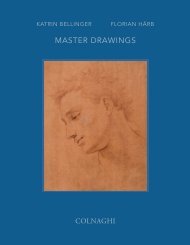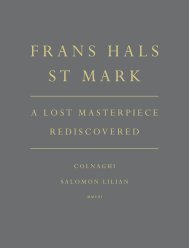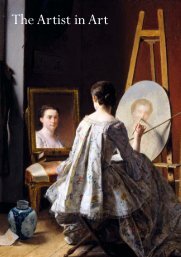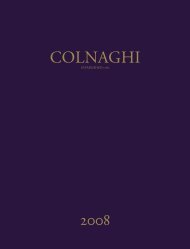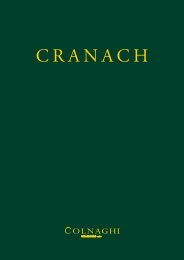2007 Catalogue - Colnaghi
2007 Catalogue - Colnaghi
2007 Catalogue - Colnaghi
You also want an ePaper? Increase the reach of your titles
YUMPU automatically turns print PDFs into web optimized ePapers that Google loves.
Of all the European artists who made their way to Italy<br />
during the seventeenth century to study at the<br />
fountainhead of art, the still-life and the landscape<br />
painters of Flanders demonstrated the greatest capacity<br />
to assimilate the native culture and to enter the<br />
mainstream of Italian society. This phenomenon was<br />
exemplified in its every detail by the career of the<br />
still-life painter Abraham Brueghel.<br />
Abraham Brueghel was the most talented and<br />
successful son of Jan Brueghel the Younger. Trained<br />
by his father, he had already sold a small flower<br />
painting by his son when Abraham was just fifteen<br />
years old. Like his grandfather Jan Brueghel the Elder,<br />
also known as the Velvet Brueghel, Abraham travelled<br />
to Italy. It was the preference for many young aspiring<br />
artists to complete their training and gain invaluable<br />
experience before returning home, however Brueghel<br />
never returned. He settled in Rome where he quickly<br />
established a reputation for his still-lifes. Already in<br />
1649 an inventory of his patron Prince Antonio Ruffo<br />
records nine flower paintings by the eighteen-year-old<br />
artist. During the 1670s Brueghel moved to Naples,<br />
where he remained for the rest of his life.<br />
07<br />
Abraham Brueghel<br />
(Antwerp 1631 – 1697 Naples)<br />
Still-Life of a Watermelon, Cherries, Peaches, Apricots, Plums, Pomegranate<br />
and Figs with Lilies, Roses, Morning Glory and other Flowers on an Acanthus Stone Relief,<br />
a mountainous Landscape beyond<br />
Signed lower left: ABrughel. Fe (AB linked)<br />
Oil on canvas<br />
53 3 /8 x 69 1 /2 in. (135.6 x 176.5 cm.)<br />
32<br />
His native predilection for decorative profusion and<br />
anecdote, Brueghel seamlessly grafted the sweeping<br />
movement of the High Baroque style of his Italian<br />
contemporaries, such as Michelangelo Campidoglio<br />
and Michelangelo Cerquozzi and the result can be<br />
found in compositions that appear to have been<br />
conceived with remarkable casualness, but which still<br />
maintain the firmness of composition and clarity of<br />
detail associated with the artist’s Northern heritage.<br />
Due to the relative constancy of the artist’s mature style<br />
and the scarcity of dated works, it has proved difficult<br />
to trace the chronology of the Brueghel’s artistic<br />
development. Generally it would appear that his<br />
brushstrokes were slightly more painterly during his<br />
Roman period, while his colouring became brighter<br />
and stronger during his later years. Our picture can<br />
be dated to the second half of the 1670s where<br />
the crispness of detail, the smooth handling and<br />
the strength of colour are all characteristic of his<br />
later style. 1



